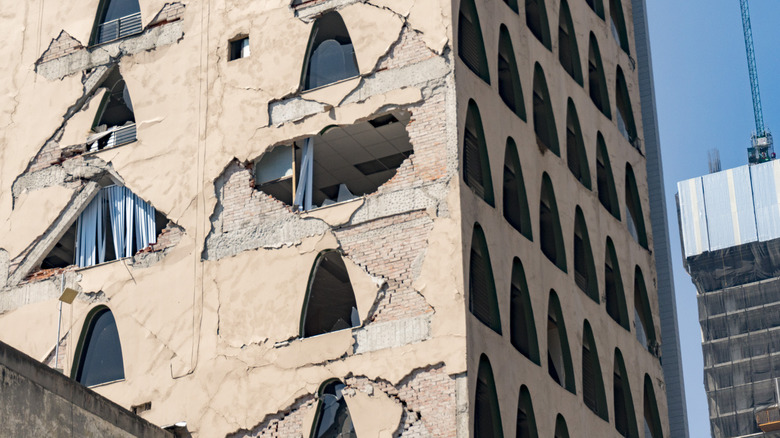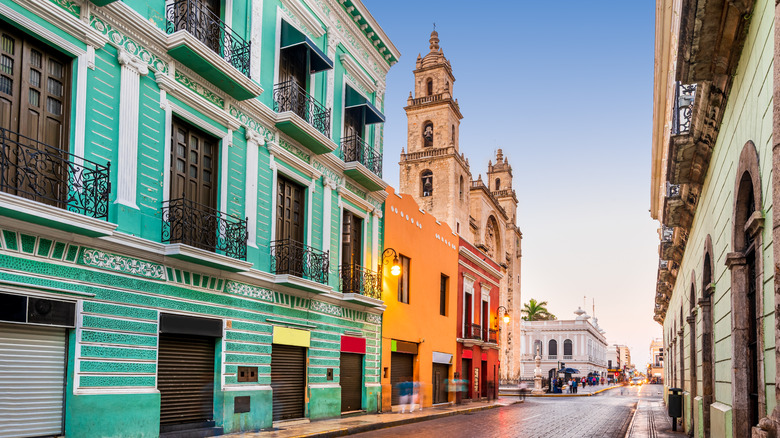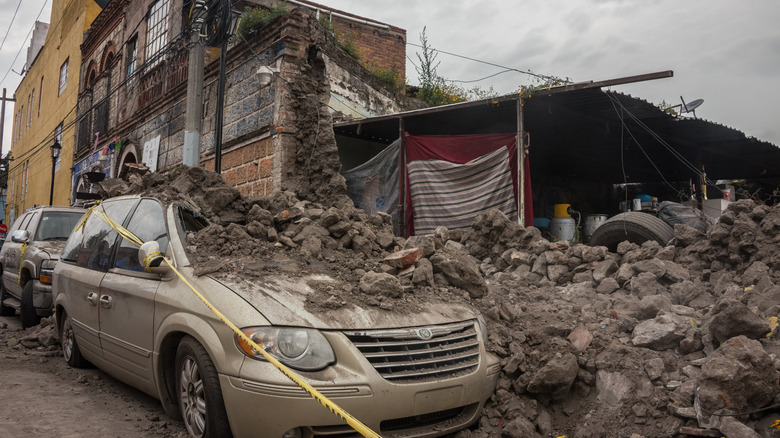Mexico's Location Makes It At Risk For Severe Earthquakes
On July 26, 2022, people in 200 towns in the Philippines felt an earthquake hit as massive rocks rolled through the streets and caused buildings to collapse, according to CNN. The damage to the Philippines was severe. The immense quake caused at least 58 landslides in the mountainous region, and hundreds of millions of dollars in damages. The Philippines is just one area along an earthquake-prone region known as the Ring of Fire — and one area in particular, Mexico, gets an incredible amount of earthquakes each year (per the U.S. Geological Survey).
The New York Times reports that Mexico is uniquely primed to have lots and lots of earthquakes, including some that measure eight or higher on the Richter scale. According to El Pais, Mexico has around 30,000 earthquakes every year, and recent ones have emanated from the heavily populated Mexico City region.
The reason for this is the Cocos plate, a huge tectonic plate deep inside the Earth (via Science Direct). Every year, it moves just 83 millimeters, but that tiny movement pushing against other tectonic plates can result in seismic shifts on the Earth's surface.
Where is the Ring of Fire?
The Ring of Fire is an underground horseshoe-shaped area stretching from Peru along the North American west coast (including Mexico), through Japan and the Philippines, and ending around the Kermadec islands (per the U.S. Geological Survey). Locations in the Ring of Fire are particularly susceptible to earthquakes due to the movements of plates deep inside the Earth.
Smithsonian Magazine reports that one of Mexico's deadliest earthquakes hit in 1985, killing 10,000 people. Part of the reason quakes are so strong in Mexico is the soil itself. When an earthquake's vibrations hit the soft basins underground, the vibrations continue to echo repeatedly — and they can even get bigger as the echoing continues, causing extra aftershocks.
That's bad news for Mexico's infrastructure, some of which is built atop soft, watery ground. Buildings just can't handle repeated waves of shaking, and will topple over. In fact, even if the buildings were prepared for earthquakes, powerful waves from the 1985 quake were five times stronger than researchers had predicted.
How to prepare for an earthquake in Mexico
Another terrifying effect of strong earthquakes, like the devastating quake of 1985, is liquefaction (via Smithsonian Magazine). Because the ground below Mexico tends to be watery, when it is shaken, the ground sucks cars and other large objects into the ground, similar to quicksand. Per Britannica, liquefaction can trigger landslides, or completely decimate areas that are built on wetlands. Then, is the threat of sand volcanoes — as the ground twists and compresses, jets of wet sand can explode into the air.
So how can you stay safe when in Mexico? Ready.gov reports that you should stay where you are as an earthquake begins. If you're outside or in a car, stay there. If you're inside, you can duck underneath a table and shelter there until the movement subsides. Stay away from any heavy objects that could fall off the walls — including during aftershocks, which will most likely happen if the earthquake is a big one. Avoid the urge to run outdoors, because you'll most likely be safer indoors.
According to the Pan American Health Association, since the particularly strong quake in 1985, the Mexican government has worked to improve its disaster preparedness by fortifying hospitals and implementing earthquake and tsunami plans.


